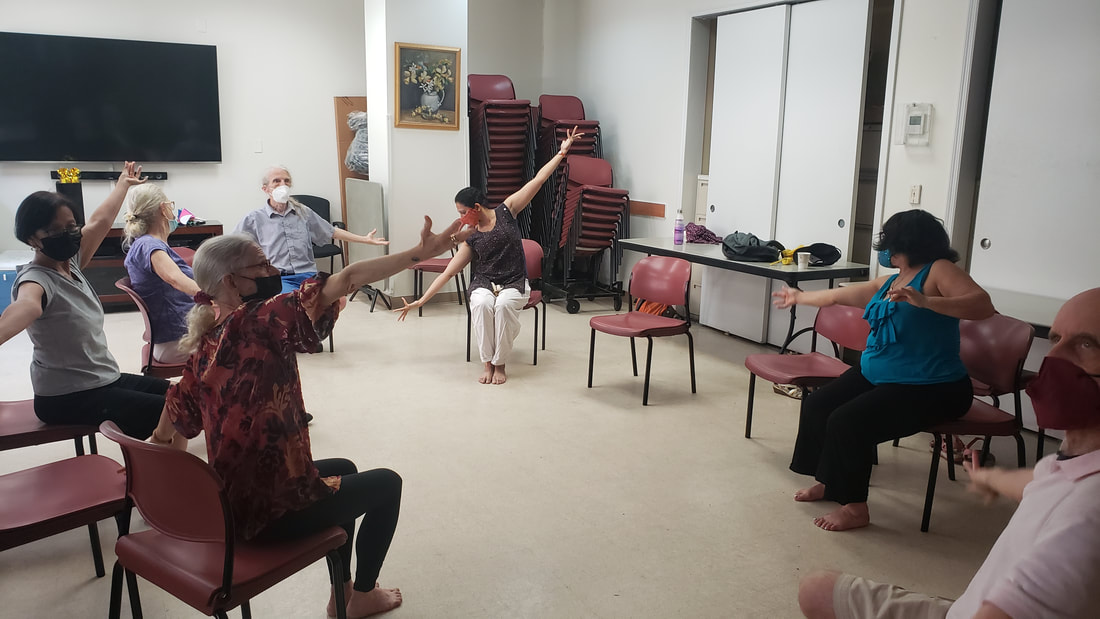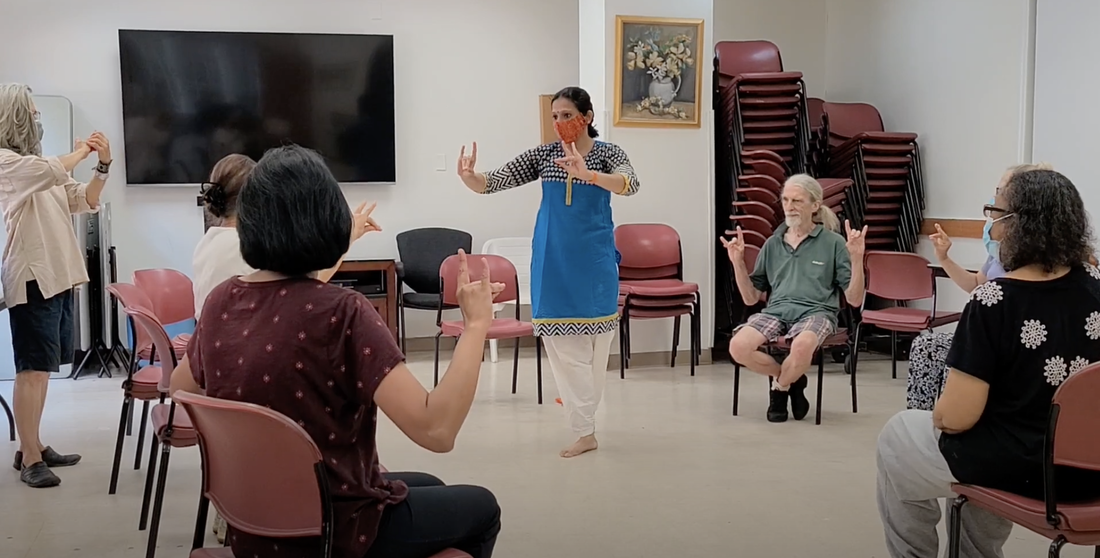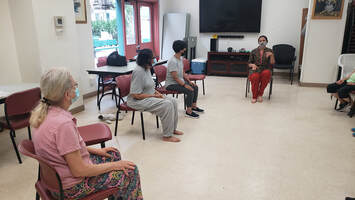 Sloka demonstrating a rhythmic pattern seated with her hands Photo credit: Padma Narayanan Sloka demonstrating a rhythmic pattern seated with her hands Photo credit: Padma Narayanan Making Bharatanatyam inclusive: the specifics In this article you will find specific ways in which I have tried to make Bharatanatyam inclusive. These methods are evolving as I get a chance to work with more organizations and participants, but the scientific principle of synaptic plasticity (the capacity of the brain to change with experiences), the positive impact of movement for mental health, and the power of self-expression lie at the core of this curriculum. Rhythm: Bharatanatyam is based on the Carnatic style of music, which has over hundred patterns of rhythm. As students of Bharatanatyam, we learn the ways in which combination of steps fits with the rhythmic patterns to give rise to aesthetically pleasing movements. While working with people that may not have had exposure to this kind of dance and music, one can think of how certain rhythmic patterns are reminiscent of daily activities. The hum of a fan, the sound of a subway approaching the station, a horse’s gallop etc. are all examples of relating rhythm to participants’ daily lives. Other ways of approaching rhythm are to have participants clap in rhythm, or seated with hands on their laps. Reciting the syllables (the “sollukuttu) is another way people can engage. The beauty of this approach, I feel, is that participants have a variety of ways to engage and that they can be layered on top on one another. So, a participant may want to start by clapping to the rhythm in various speeds, then add reciting the syllables, then adding the feet seated, and finally, clapping, reciting, and responding to the rhythm standing up, and perhaps even moving in space! I have found that these are additional ways to embody rhythm and are quite helpful and most importantly, help build an inclusive approach. 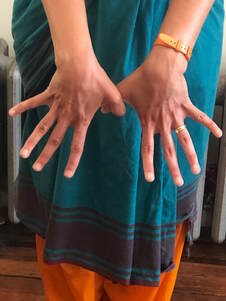 Sloka demonstrating a bat with her hands Sloka demonstrating a bat with her hands Rasas: Bharatanatyam has in it codified the nine emotions of laughter, compassion, anger, courage, fear, disgust, wonder, and peace. For an older adult population specifically, the language of navarasas can be very useful to talk about things relevant in participants' lives. One participant, while talking about the emotion of love (sringara) shared how for her, love was tinged with grief at just having lost her partner. Mudras or hand gestures: Students of Bharatanatyam are taught more than 50 mudras that use either one, or both hands. Many of these mudras (e.g., the crown of a king using tripataka) may not be that relevant to a contemporary audience. But I have found that one way to incorporate such mudras could be to ask participants to show a king as a king vs. a king when a child is acting as though he is a king. Bharatanaytam is a living, evolving language, and hand gestures are a great way to have participants contribute to this language (e.g. the hasta for a bat is one that I created after studying about bats and how they fly). 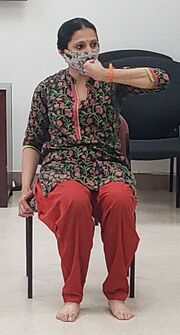 Sloka showing the trunk of an elephant to seated participants. Photo credit: Padma Narayanan Sloka showing the trunk of an elephant to seated participants. Photo credit: Padma Narayanan Music and chanting: For audiences that may have had some exposure to Indian music, one can use music for warm-up or to cool down at the end. As a student of Carnatic music from Smt. Nivedita of Raga Chitra Fine Arts, I have brought in music set in certain melody (“raga”) to convey a specific mood or feeling. Storytelling: Pieces in Bharatanatyam can be those that explicitly tell a story, or those that convey a mood. I have found storytelling through mudras, rasas, and rhythm to be a very effective way to get people from all backgrounds engaged. Storytelling using the eyes and facial expressions can also be very powerful and creative aids to bring to life to a narrative structure and a story. Visualization: One of my favorite pieces in Bharatanatyam is where the dancer (the storyteller) is visualizing Lord Nataraja – the god of dance. The feeling of the piece is to communicate the feeling of awe the dancer feels at having seen such a divine being. The strategy I use to bring across this feeling is to imagine a dinosaur standing in front of me in the flesh. While there will be feelings of fear and apprehension, I would think that the primary emotions would be of surprise, of wonder, and awe. In a similar way, for an older adult population, I have used the imagery of baby elephants playing with other baby elephants as well as other elephants in the herd. I felt that this was a great choice, as by default, elephants are stable. Additionally, elephants are almost never in a rush, which also helps in the comfort level of participants, as does the inherent playfulness of babies, and baby elephants in particular. Evoking elephants may come in handy if the participants have a fear of falling because their stability evokes and inspires confidence. A short video where I am demonstrating this can be found below. The video is part of the Dance for PD Community Festival: Around the World, Around the Clock, a FREE 24-hour virtual celebration that featured classes, panel discussions, and film screenings to highlight the diversity and breadth of the Dance for PD family. You will see that I am seated, and am demonstrating the trunk of an elephant to seated audiences, giving participants multiple options to participate, and bringing in imagery of baby elephants playing with the other babies and adults in the herd. Movements done seated or standing, with the support of a chair: While there are many aspects of Bharatanatyam that can be done seated, the dance form also has a very rich vocabulary of movements that are done in a specific sequence. Movements (adavus) making up the sequence of movements (jatis) can be done seated in order to make Bharatanatyam more inclusive, I have re-imagined many jatis in a way so that they can be done either seated, or with the support of a chair. 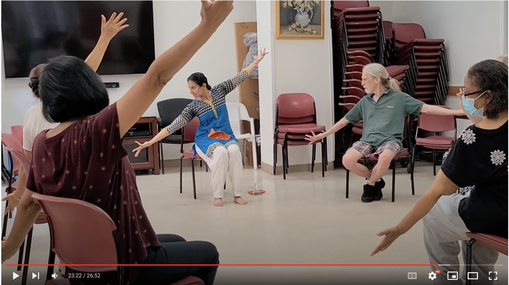 Sloka working with participants at the YM & YWHA of Washington Heights and Inwood on how to work on our gaze. Photo credit: Tom Frambach Sloka working with participants at the YM & YWHA of Washington Heights and Inwood on how to work on our gaze. Photo credit: Tom Frambach The power of the gaze: Students of Bharatanatyam are trained to pay a lot of attention to their eyes, how their eyes appear to the audience, and our goal is always to make our gaze expansive, not limiting. I have found that working on specific eye movements can be of tremendous benefit to seniors, as it gives them an opportunity to practice their eye coordination. 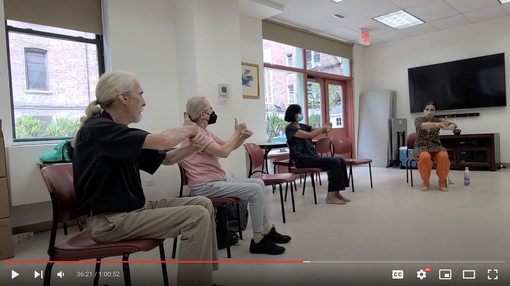 Sloka working with participants at the YM & YWHA of Washington Heights and Inwood on the famous slokam Mooshika Vahana. Photo credit: Tom Frambach Sloka working with participants at the YM & YWHA of Washington Heights and Inwood on the famous slokam Mooshika Vahana. Photo credit: Tom Frambach Using repetition to engage participants' creativity: Students of Bharatanatyam and Carnatic music know the power of repetition, and why we repeat a certain verse a number of times. As a child, I failed to understand its purpose, but over time, I've realized we repeat lines or stanzas for emphasis, to highlight a verse's derived meaning, to provide depth to a rasa, and to tell the story through another character. With my participants at Center for Adults Living Well @ the Y and DOROT, I have been working on the famous sloka "Mooshika Vahana". The first repetition gives us a chance to explore the "paadartha" (the word-by-word meaning), but I've been able to use subsequent repetitions to co-create choreography from the point of view of Ganesha's mouse (as an example). For this particular purpose, I was able to incorporate the rasa of hasya into subsequent repetitions. In future articles, I will write in detail how the aspects of rhythm, storytelling, hand gestures etc. can be used in the form of videos and in-depth articles.
0 Comments
Leave a Reply. |
AuthorMy name is Sloka. I am a neuroscientist and dancer; you can find more about me here. Archives
June 2024
|
